|
AQUACULTURE
ABOUT - CLIMATE
- CONTACTS -
DONATE
- FOUNDATION -
PLASTIC - HOME - A-Z INDEX
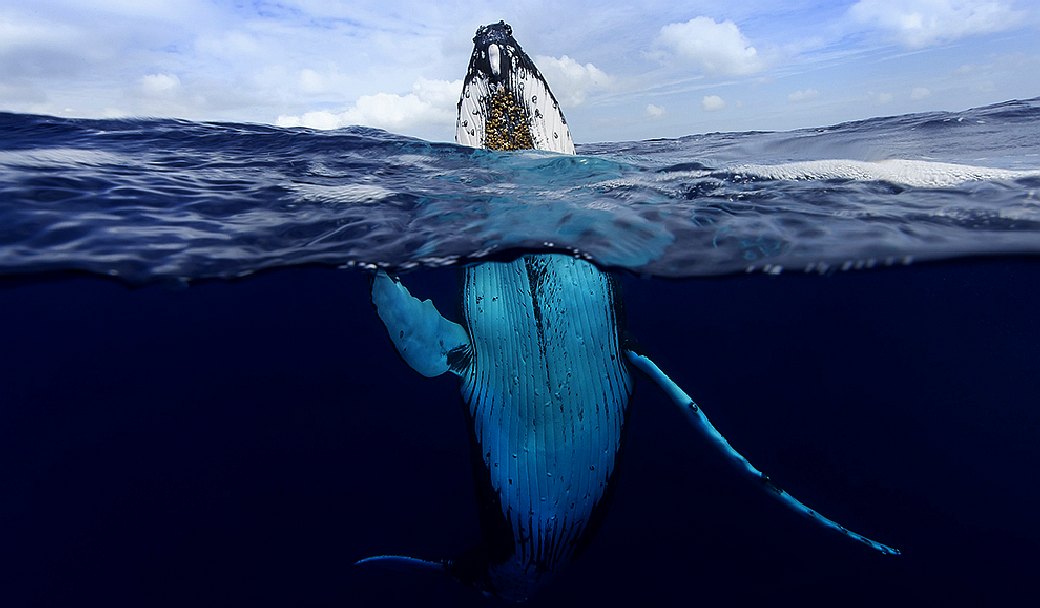
A
FARMER'S LIFE FOR ME - Farming finfish, shellfish and aquatic plants is one of the world's fastest growing food sectors, it already provides the planet with about half of all the fish we eat.
The Australian Government identified the need for fish feed
other than from wild fish with their Blue
Economy Challenge - so well done to them for that.
While
not the most efficient way of producing fish protein at the
moment, aquaculture offers a breathing space to allow wild
fish stocks to recover, provided that the red-tape barriers to
production are reduced - with safety in mind of course. In the
longer term, we are looking for sustainable aquaculture based
on feed that does not impinge on wild fish stocks. Some
of the best ideas under development include using insects
to produce fish food.
Aquaculture is the fastest-growing food sector in the world. Most farmed seafood is currently produced in freshwater environments such as ponds, land-based tanks and raceways, but some producers are expanding to the open ocean.
Aquaculture dates back thousands of years, but has only recently become an essential part of our global food system. However, most of the world's wild
fisheries are already fished at their maximum sustainable
yield until such time as fish have a healthier environment, so aquaculture
looks set to be the primary source of seafood for some time into the future.
Hence, we need to understand how to farm fish and shellfish sustainably. We do not have
a broad-scale understanding today about the ecological limits and potential of cultivating seafood in the oceans.
A recently published study estimated that the offshore potential for aquaculture in marine waters, based on the growth performance of 180 farmed fish and shellfish
species - calculated that marine aquaculture could produce as much seafood as all of the world's wild marine fisheries, using less than 0.015 percent of the space in the world's oceans.
Total global wild catches have remained relatively unchanged for the past two decades. In 2015, 92 million tons of wild species were harvested worldwide – the same amount as in 1995. In contrast, seafood production from aquaculture increased from 24 million tons to 77 million tons during the same time period, and is still rising to help meet growing demand.
It is estimated that the world will need around 40 million more tons of seafood as soon as 2030.
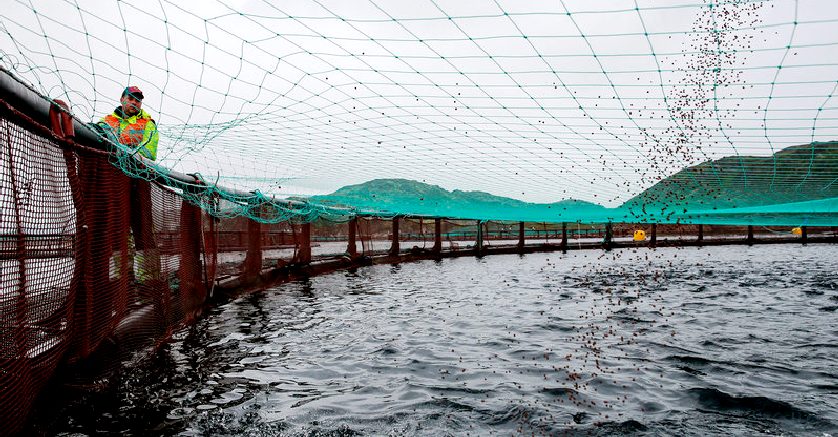
THE
SEA OF PLENTY - After two years of analysis by an expert working group, it was found that 3 percent of the world's oceans appears very suitable for marine aquaculture. This may sound small, but it is actually an extraordinary amount of area, spread across nearly every coastal country in the world – about four million square miles.
A recent study used publicly available open source data and previous physiological and growth research to model and map the potential of aquaculture in the oceans for fish and bivalves, such as oysters and mussels. In addition to accounting for the biological limits of each species, avoiding areas of the ocean that are used for shipping and oil extraction, as well as marine protected areas and depths greater than 200 meters, as a proxy for the limitations of cost and current farm technology.
We don't even need to use that entire area to meet world seafood demand. If aquaculture were developed in only the most productive areas, the oceans could theoretically produce the same amount of seafood that is currently caught by all of the world's wild-caught fisheries, using less than 0.015 percent of the total ocean surface – a combined area the size of Lake Michigan. This is possible because many aquatic species can be farmed very efficiently, and because farming in the oceans can spread in three dimensions, across the surface of the ocean and downward below the waves.
Many regions that are likely to contend with high population growth and food insecurity, such as India, the Middle East and Pacific island nations, show particularly high potential for marine aquaculture, which suggests that we can produce food where it is most needed.
EU AQUACULTURE
In Europe, aquaculture accounts for about 20% of fish production
for human consumption and directly employs some 85,000 people. The sector is mainly composed of SMEs or micro-enterprises in coastal and rural areas.
The EU claim that their aquaculture is renowned for its high quality, sustainability* and consumer protection standards.
EU overall output has been more or less constant in volume since 2000 whereas global production, at the same
time has been growing by nearly 7% per year. Given that SMEs
are the prime mover, cutting through the red tape is an
obvious step to increasing interest from entrepreneurs.
BATTERY
FARMING Aquaculture
is the aquatic version of battery farming chickens in cages,
save that the cages are larger. Fish
farming cages are usually located out to sea close to
shore. Carcinogenic
toxins in the water that are concentrated in microplastics
will still reach and be ingested by the caged fish and so will
enter our food chain. For this reason many fish farms are
located in relatively cleaner waters; or should be.
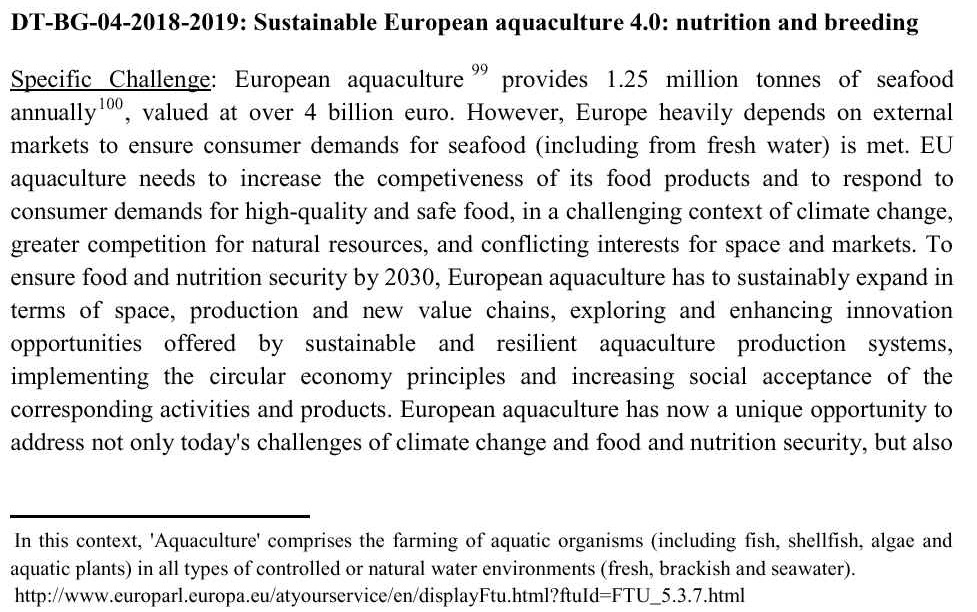
UK
AQUACULTURE POLICY
The
UK's policy is published in a .pdf
format that is not open-able by most visitors to their
website. How this complies with the requirement to be
transparent and especially as this apparent cloaking may
affect research and data availability purposes defies all
logic. We suggest that UK departments update their sites to
make sure that such important documents are in a format that
can be opened by software that is free to all users
internationally.
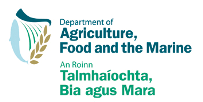
IRELAND
AQUACULTURE POLICY
National Strategic Plan for Sustainable Aquaculture Development
Article 34 of the Common Fisheries Policy Regulation requires Member States to prepare multi-annual national strategic plans for
aquaculture. The national plans are intended to inform investment priorities for aquaculture under Member States’ operational programmes under the European Maritime and Fisheries Fund. They are also intended to identify measures to reduce the administrative burden on operators, to secure sustainable development and growth of aquaculture through coordinated spatial planning, to enhance the competitiveness of the aquaculture sector and to promote a level playing field for EU operators by exploiting their competitive advantages.
Ireland’s National Strategic Plan for Sustainable Aquaculture Development was finalised on 23 October 2015, following public consultation earlier in 2015. The Plan was submitted to the European Commission on 23 October 2015.
The National Strategic Plan for Sustainable Aquaculture Development proposes 24 actions to be implemented over the period up to 2020.
National Strategic Plan for Sustainable Aquaculture Development (Final
pdf 11,462Kb)
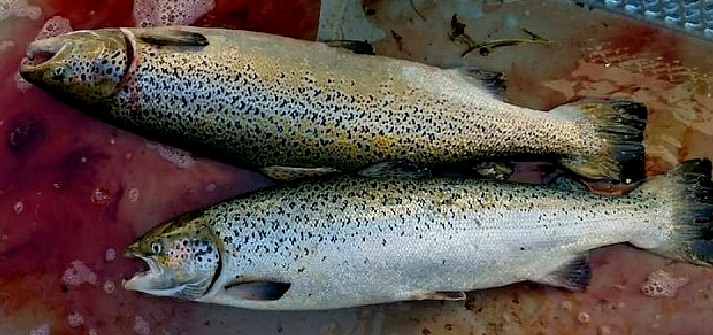
SALMON
ESCAPE AUG 2017 - Commercial fisher Ellie Kinley posted pictures of
Atlantic salmon she said were caught after Cooke Aquaculture's net pen broke, releasing thousands of the invasive species into
Pacific waters. There is no way to confirm if the fish pictured here are the fish that
escaped other than DNA testing. Source: CBC News. People are more worried about broad impacts on the environment and fishing. Just as unchecked fishing practices can damage ecosystems and wildlife, poorly sited and improperly managed fish farms can produce significant quantities of pollution and have the potential to spread diseases to wild species.
GUIDELINES
FOR SUSTAINABLE EU AQUACULTURE - 52013DC0229
COMMUNICATION FROM THE COMMISSION TO THE EUROPEAN PARLIAMENT, THE COUNCIL, THE EUROPEAN ECONOMIC AND SOCIAL COMMITTEE AND THE COMMITTEE OF THE REGIONS
Strategic Guidelines for the sustainable development of EU aquaculture
1. Introduction
European aquaculture offers good quality products, respecting strict environmental sustainability, animal health and consumer protection standards. The excellent quality of EU seafood[1] should constitute a major competitive advantage for EU aquaculture; however, the EU aquaculture production is stagnating, in contrast with strong growth in other regions of the world.
In 2010, the value of EU aquaculture production was € 3.1 billion for 1.26
million tonnes of production. The EU seafood market is currently supplied for 25% from EU fisheries, 65% from imports and 10% from EU aquaculture.[2] EU total apparent consumption of fishery and aquaculture products reached some 13.2 million tonnes.[3]
Available data show a growing gap – estimated at 8 million tonnes – between the level of consumption of seafood in the EU and the volume of captures from fisheries. The Commission and Member States can help ensuring that this gap is partly filled by environmentally, socially and economically sustainable EU aquaculture.
Based on current labour productivity, each percentage point of current EU consumption produced internally through aquaculture would help create between 3,000 and 4,000 full-time jobs.[4] This figure confirms that, although aquaculture represents a relatively small part of the EU economy, it has the potential to boost growth and jobs in EU coastal and inland areas. A close cooperation with the processing industry can further improve job creation and competitiveness in both sectors. Aquaculture is one of the pillars of the EU's Blue Growth Strategy[5] and its development can contribute to the Europe 2020 Strategy.
2. Aquaculture in the Common Fisheries Policy Reform
The proposal for the Common Fisheries Policy (CFP)[6] reform aims to promote aquaculture through an open method of coordination: a voluntary process for cooperation based on Strategic Guidelines and Multiannual national strategic plans identifying, common objectives and, where possible, indicators to measure progress towards these goals.
To achieve these aims, all relevant actors should be engaged: authorities, the industry, retailers, consumer associations as well as representatives from the civil society. The proposed Aquaculture Advisory Council is designed to play an important role in this sense.
These Strategic Guidelines aim to assist the Member States in defining their own national targets taking account of their relative starting positions, national circumstances and institutional arrangements. Issues covered by EU legislation are not addressed under the open method of coordination, but they provide the framework for its activities.
Aquaculture is dependent on clean and healthy marine and fresh waters. EU environmental legislation – in particular the Water Framework Directive (WFD)[7], the Marine Strategy Framework Directive (MSFD)[8] and the Regulation concerning use of alien and locally absent species in aquaculture[9] – ensures that these preconditions are met. EU legislation also establishes the high health, consumer protection and environmental sustainability standards that EU aquaculture activities have to comply with. These have cost implications for producers, but can be turned into a competitive advantage if the attention of the consumers is drawn on quality, and can also contribute to local acceptability of aquaculture. The CFP reform builds upon these high standards.
The Commission intends to help national and regional administrations to implement EU environmental legislation without imposing unnecessary burdens on producers. To this end, Guidelines on the integration of aquaculture in Natura2000 sites have been published,[10] and the Commission intends to start working on similar Guidelines on aquaculture and the WFD and the MSFD.
3. Strategic Guidelines for the sustainable development of EU aquaculture
This Communication is based on the outcome of consultations with stakeholders, and takes into account the analysis performed by the Joint Research Centre.[11] Four priority areas will be addressed in order to unlock the potential of EU aquaculture: administrative procedures, coordinated spatial planning, competitiveness and a level playing field.
Aquaculture can contribute to the overall objective of filling the gap between EU consumption and production of seafood in a way that is environmentally, socially and economically sustainable. To this aim, each Member State is encouraged to indicate in the multiannual national plan its own aquaculture growth objective (volume and value) in the period covered by the plan.
3.1. Simplify administrative procedures
Administrative costs and lead time play an important role in determining the overall competitiveness and development of an economic sector. At the moment, only limited information is available on time taken and the costs of issuing licenses for a new aquaculture farm, and the Commission is unaware of any comprehensive mapping exercise of the main bottlenecks. Available information suggests that in several Member States authorisation procedures often take around 2-3 years to complete;[12] examples of substantially longer times have also been reported. For comparison, data reported in a European Parliament study suggest that the average licencing time for aquaculture farms in Norway used to be 12 months and has been reduced to 6 months with the introduction of a "single contact point".[13]
Licencing time for aquaculture farms in some Member States and Norway (months)
= licencing time for new aquaculture farms
= average licencing time for offshore wind farms across the EU[14]
= reported licencing time for agricultural farms in two Member States
= target licencing time for new SMEs (Entrepreneurship 2020 action plan)
Sources: own elaboration based on data from SHoCMed, Windbarriers, European Parliament study IP/B/PECH/NT/2008 176 and information provided by producers associations and public authorities.
Most aquaculture producers are SMEs, and they are disproportionately affected by red tape: the relative weight of regulatory and administrative costs compared to turnover and number of employees can be up to ten times higher for SMEs than for large companies in the general economy[15]. Reducing unnecessary regulatory burden remains on the top of the Commission’s political agenda. As a follow up to the Small Business Act review of April 2011, the Commission has proposed an Action Plan to support entrepreneurship in Europe. The Action plan invites the Member States to reduce time for licensing and other authorisations necessary to start a business activity to one month by the end of 2015[16] provided that requirements of EU environmental legislation are met. As a first step, a comprehensive mapping and screening exercise needs to be performed:
· Target for the Member States: With the objective to identify possibilities to improve procedures and to reduce administrative burdens, Member States are encouraged to collect information by the end of 2013, on:
(1) Number of new licences granted in the period 2007-2013 (n.)
(2) Success rate of applications for licences (%)
(3) Number of applications currently being processed (n.)
(4) Average time to complete licencing procedures (months)
(5) Number of public bodies involved in authorisation procedure (n.)
(6) Average costs of licencing procedures for new business (€)
(7) Average duration of a licence (years)
· Targets for the Commission: On the basis of the data collected by the Member States, to work with relevant authorities to identify by summer 2014 best practices and margins for improvement including through the support of the Commission High Level Group on Administrative Burdens, whose mandate is to help Member States' public administrations to implement EU legislation in a way that is more efficient and responsive to the needs of stakeholders.[17] To prepare by second quarter 2014 guidance documents addressing the requirements of the WFD and the MSFD in relation to aquaculture, in order to assist Member States and the industry in the implementation of EU law and illustrate how environmental protection can be compatible with sustainable aquaculture.
· Target for Aquaculture Advisory Council: to perform by April 2014 a screening of administrative procedures and a mapping exercise of the main administrative burdens in terms of time and costs in different types of aquaculture in the Member States.
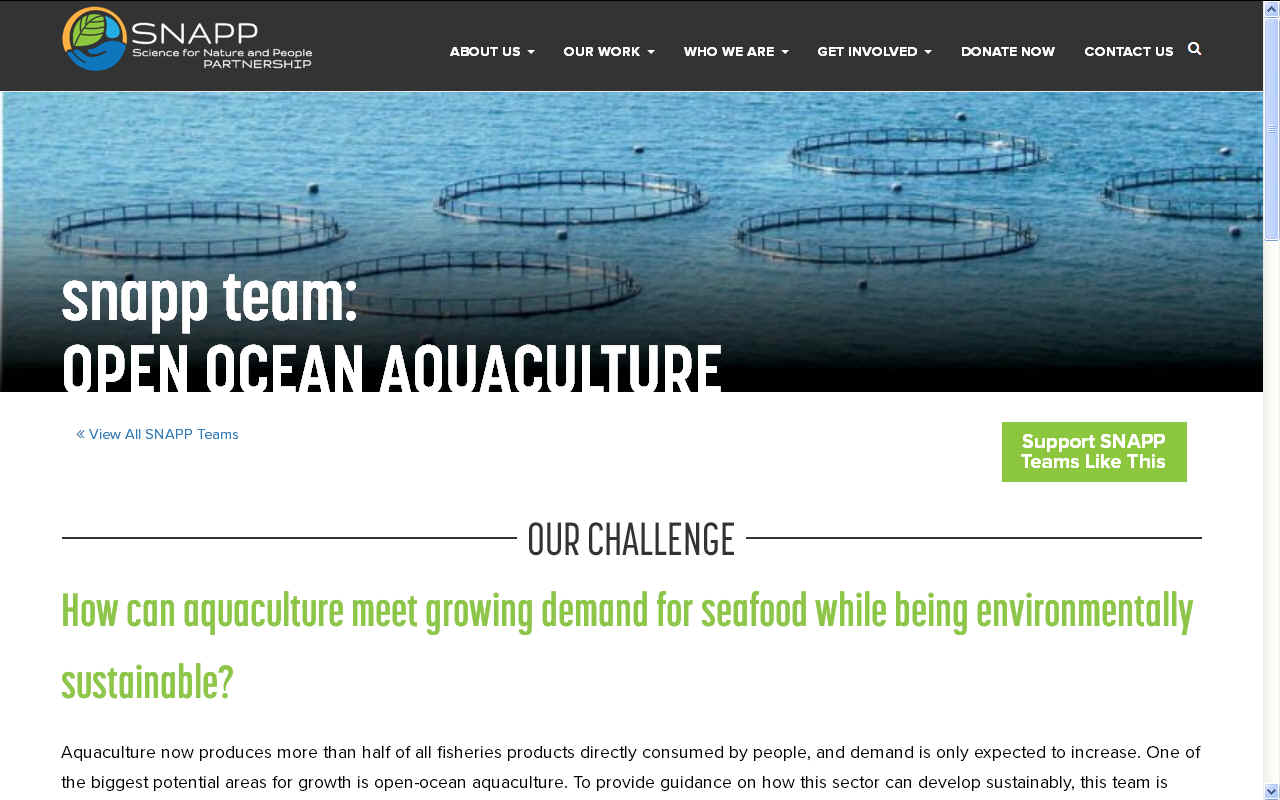
SNAPP -
Their work is solution-driven — whether influencing policy change, sharing
research in popular magazines, introducing new decision-making tools, or providing guidance documents to the conservation and development communities.
Their teams have published high-impact science papers that have influenced the way global leaders like the
World Bank and re-insurance industry think about nature’s role in the protection of people.
Expanding sustainable marine aquaculture will depend on creating economic and regulatory policies that help the industry grow while also protecting the health of the marine environment and the local communities that depend on it.
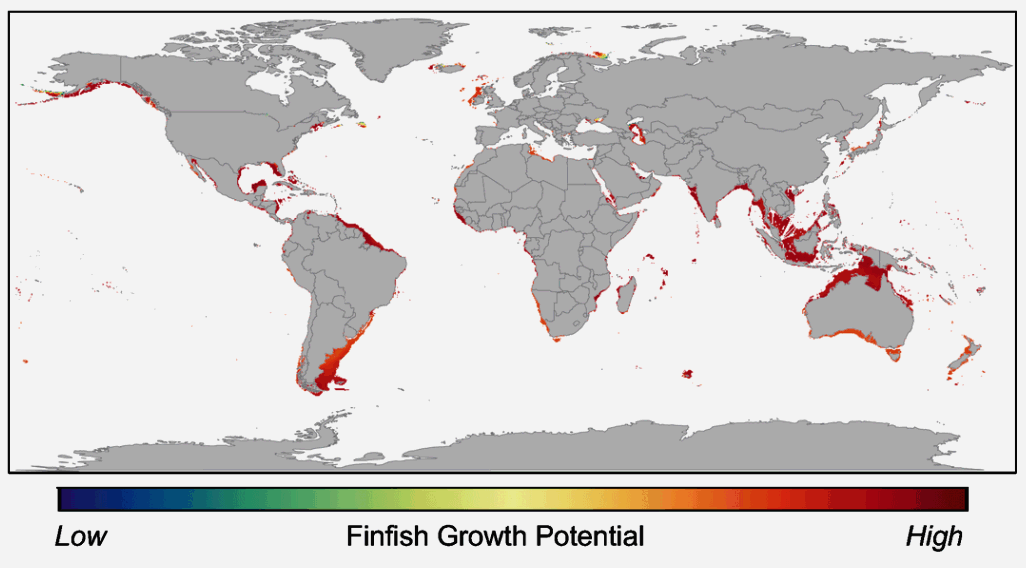
Several studies have shown that siting fish and shellfish farms more than one nautical mile offshore, where water is deeper and currents are faster, can significantly reduce pollution and improve the condition of farmed species when compared to nearshore production of the same species in the same region.
3.2. Securing sustainable development and growth of aquaculture through coordinated spatial planning
Different studies have shown that having spatial plans in place can help reducing uncertainty, facilitating investment and speeding up the development of sectors such as aquaculture or offshore renewable energy[18]. The lack of space often cited as a hindering factor for the expansion of EU marine aquaculture can be overcome by identifying the most suitable sites amenable for aquaculture, as the current surface and coastline occupation by aquaculture activities appears to be limited[19].
Inland planning is usually more advanced compared to maritime planning, due e.g. to the existence of cadastre or rating systems making information easily accessible to all relevant institutions. The identification of the most suitable areas for freshwater aquaculture will help expanding production while enhancing landscapes, habitats and biodiversity protection. Spatial plans should take into account the environmental services provided by extensive pond-based aquaculture.
In many cases, the needs of aquaculture alone will not justify carrying out such a complex exercise for the marine environment. However, this approach was followed in the case of e.g. the Irish experience with CLAMS,[20] the Galician regional strategy for aquaculture[21] and the national aquaculture spatial planning project in Finland.[22] Existing planning exercises, such as e.g. offshore wind platforms siting plans,[23] can be used as a starting point. Guidelines on spatial planning in the Mediterranean[24] and in the Baltic[25] have been produced and can provide inputs to Member States. Furthermore, data collected in the implementation of existing legislation (e.g. the Renewable Energy Directive, CFP, MSFD, WFD, Habitats and Birds Directives) can also be used for aquaculture planning. The Commission has adopted in March 2013 a proposal for a Directive establishing a framework for Maritime Spatial Planning and Integrated Coastal Management.[26] The Member States will remain responsible for designing and determining the overall objectives and content of such plans.
Aquaculture may affect significantly the environment if not properly designed and monitored. Therefore, some environmental impacts of aquaculture (e.g. nutrient and organic matter enrichment, contamination by hazardous substances) are specifically addressed in EU legislation. The overall impacts of individual farms will also include other kinds of pressure (e.g. sedimentation, physical disturbance) and will be influenced by other factors, including e.g. the type of cultured organisms, the location of the farm and the vulnerability of the local environment. According to a European Parliament study[27], assessing these environmental aspects in the frame of the spatial planning process can reduce the administrative burden for private developers and limit uncertainty in the licencing procedures, thus making investments more attractive. Several studies and experience in other industrial sectors[28] confirm that addressing this kind of issues in the early stages of the planning process minimises environmental impacts, reduces local opposition, prevents unnecessary delays and increases the chances of success of new projects. This kind of experience can provide valuable guidance to aquaculture producers and help increasing the sustainability, social acceptance and competitiveness of EU aquaculture.
As space and environmental carrying capacity in both marine and inland waters are limited, an ecosystem based approach should be applied. Special care should be taken when dealing with vulnerable and protected areas, through sound planning and assessment procedures; positive experiences with the integration of aquaculture in Natura2000 sites show the possible compatibility of a profitable commercial activity with the conservation of biodiversity. The environmental services provided by extensive pond aquaculture are a concrete example where an economic activity meets the conservation needs of a habitat or species.
· Target for the Member States: to put in place coordinated spatial planning, including maritime spatial planning at sea basin level, to ensure that aquaculture's potential and needs are taken into account and to secure an adequate allocation of space in waters and land for sustainable aquaculture development.
· Target for the Commission: to monitor the implementation of coordinated maritime planning, to disseminate studies and experiences to help Member States in their planning. To organise a best practice exchange seminar in summer 2014.
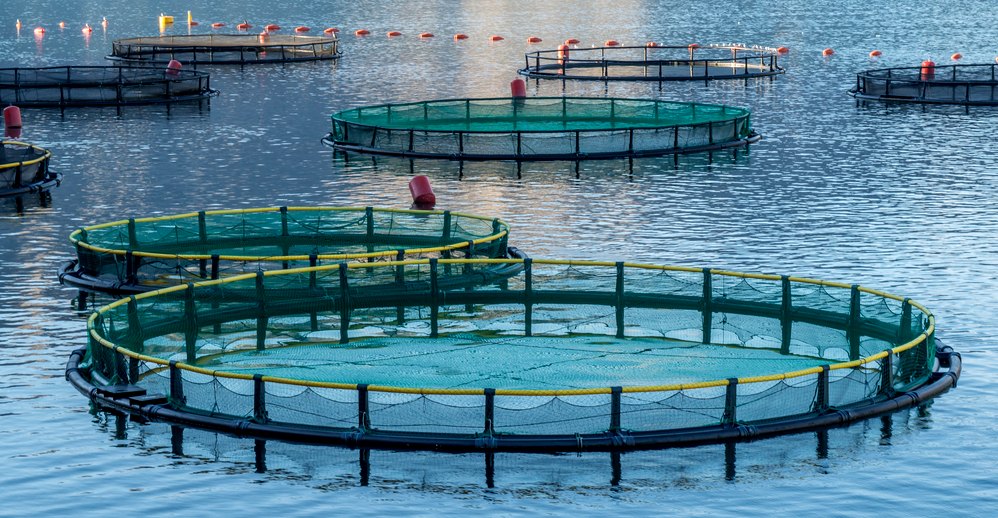
OPEN
WATER FISH TANKS - Today aquaculture is the fastest-growing food sector in the world. Most farmed seafood is currently produced in freshwater environments such as ponds, land-based tanks and raceways, but some producers are expanding to the open ocean.
This means that we need to understand how to farm fish and shellfish sustainably. We do not have broad-scale understanding today about the ecological limits and potential of cultivating seafood in the oceans. As a first step, we recently published a study that estimated the offshore potential for aquaculture in marine waters, based on the growth performance of 180 farmed fish and shellfish species.
It
has been calculated that marine aquaculture could produce as much seafood as all of the world's wild marine fisheries, using less than 0.015 percent of the space in the world's oceans.
3.3. Enhancing the competitiveness of EU aquaculture
EU aquaculture enterprises are faced with different challenges and opportunities requiring tailored solutions,[29] but will all benefit from an improved market organisation and structuring of aquaculture producer organisations. These are a priority for the reform of the Common Market Organisation (CMO) and for the new European Maritime and Fisheries Fund (EMFF). Production and marketing plans, together with the EU Market Observatory should help aquaculture producers to identify business opportunities and to adapt their marketing strategies.
The growing expectations from consumers for quality and diversity of food products, especially if locally produced, offer new possibilities to give value to the assets of coastal and inland areas. Coordinated action at local level between entrepreneurs, public authorities, associations, research, education and training organisations can help stimulating local economies and meet the growing demand for locally, sustainably produced seafood.
Business diversification may provide additional sources of income for farmers. For example, the integration with angling and tourism, or the internalisation of some upstream or downstream activities, can provide business opportunities for aquaculture producers.
Business development and diversification can also be promoted by market-driven research, innovation and knowledge transfer. To this end, the Member States should foster synergy between national research programmes and promote the participation of industry in research and innovation activities – including in particular to implement the European Aquaculture Technology and Innovation Platform's Strategic Research Agenda and the Blue Growth strategy.[30]
Extensive fish pond aquaculture supports biodiversity and is widespread in particular in Central and Eastern Europe, offers important services and business opportunities besides food production, which can result in higher competitiveness if adequately valorised. The impacts of the rules applying to biodiversity-rich areas such as Natura 2000 sites and income forgone due to protected predators such as cormorant as well as voluntary commitments to protect biodiversity or water should be recognised by public authorities. One important factor affecting pond-based aquaculture production in certain regions is related to predators – in particular cormorants. The Birds Directive[31] sets out a derogation system to protect fisheries' and aquacultures' interests. Member States can make full use of the derogation provisions to prevent serious damage by cormorants to fisheries or aquaculture. In order to assist the Member States, the Commission has recently published a guidance document[32] with the aim of clarifying the key concepts in relation to the implementation of the derogation system.
· Target for the Member States: To make full use of the proposed CMO and EMFF to support business growth through adequate allocation of funds to aquaculture including for production and marketing plans and to improve the links between R&D and the industry (especially SMEs). To support educational & vocational programmes covering the needs of the aquaculture sector.
· Target for the Commission: To coordinate and support research and innovation for aquaculture through all the relevant EU programmes and funds. To promote the transfer of knowledge, best practices and innovation, including EU research project findings. To deliver a user friendly EU market Observatory to provide market intelligence.
3.4. Promoting a level playing field for EU operators by exploiting their competitive advantages
High environmental, animal health and consumer protection standards are among the EU aquaculture's main competitive factors and should be more effectively exploited to compete on the markets.
Existing sanitary checks of EU and imported products already ensure a high level of food safety. Societal concerns have also resulted in demand from consumers, NGOs and retailers for assurances that the food they purchase has been produced respecting very high environmental and social sustainability standards. If the level of sustainability of EU aquaculture products is correctly addressed and communicated to the public, this can improve the competitiveness and societal acceptance of EU aquaculture and its products. New labelling provisions as proposed in the CMO Regulation may help better differentiation of EU aquaculture products; voluntary certification schemes can also play a role in this context. The development of short food circuits can also give additional value for proximity to high quality and extra-fresh local products.
Experience in the agricultural sector confirms that there is a growing demand for sustainable, high quality food. For instance, in the last ten years the growth rate of organic food retail sales in the four largest EU markets has outpaced the overall demand growth for food products in the EU, with average yearly growth rates of 7-15% for organic food against 2-5% for non-organic.[33] According to FAO, organic aquaculture production in Europe increased by close to 30% annually between 1998 and 2007. Some retailers play an important role in bringing certified fish products to the marketplace, and do so as part of their overall corporate social responsibility commitments; the entry of major retailers has been one of the decisive factors leading to the rapid growth of the organic food sector in the last decade.
The EU promotes high environmental, social, sanitary and phytosanitary standards across the board in the framework of trade agreements that it negotiates with third countries, including with regard to aquaculture.
· Target for the Member States: To support the development of producer and interbranch organisations including at transnational level. This would facilitate collective management and/or self-regulatory initiatives between producers, processors, retailers, in cooperation with consumer associations and NGOs where appropriate. To support, implement and control labelling requirements and provisions.
· Target for the Commission: To ensure that labelling rules, in particular as regards freshness, provenance and commercial name are fully implemented. To improve markets transparency and disseminate markets information on trends at local, EU and international levels. To launch by the end of 2013 a Communication campaign on the strengths of EU aquaculture.
· Target for Aquaculture Advisory Council: To support structuring of the aquaculture production and marketing including certification and labelling. To contribute to improved market intelligence of the sector. To facilitate self-regulatory initiatives and help communicating these characteristics to the consumer.
4. A new governance to support EU aquaculture
The open method of coordination provides a framework for national strategy development and for coordinating policies between EU Member States. This voluntary process aims at giving practical answers to the challenges identified by the Member States and stakeholders. It involves concerted action between EU and national policies in full respect of the principle of subsidiarity.
In order to facilitate exchanges of know-how and best practices, each Member State is invited to identify a national contact point; the Commission will refer to them i.a. when organising peer reviews and when identifying and disseminating best practices.
4.1. Multiannual national strategic plan for the promotion of sustainable aquaculture
In order to better coordinate actions to promote aquaculture, Member States are required, under Commission proposals currently discussed with Parliament and Council, to prepare a multiannual national strategic plan based on the EU Strategic Guidelines presented in this Communication. The Commission has prepared a draft outline of the structure of the plan (annex 1) in order to ease Member States' work.
The multiannual national plans should cover the period 2014-2020. Member States are encouraged to make a mid-term assessment of the implementation of their plan by the end of 2017.
4.2. Complementarity with European Maritime and Fisheries Fund
The proposed EMFF is intended to support the implementation on the CFP. Each Member State would be asked to draw up an Operational Programme (OP), identifying actions that it intends to fund through the EMFF. Where aquaculture is concerned, it would be important for the OP to be consistent with the above-mentioned multiannual national plan in order to foster the coherence of the whole policy.
4.3. Exchange of best practices
The open method of coordination aims also to develop a mutual learning process across Member States. A key tool in this respect are peer review seminars where Member States can share and assess the effectiveness of identified good practices in policies, programmes or institutional arrangements, including with respect to the assessment assessing and mitigation of environmental impacts. They provide learning opportunities throughout the EU about the implementation process or policy approaches.
Member States are encouraged to submit three proposals of good practice in their multiannual national plan. The Commission intends to organise at least on a yearly basis peer review seminars to present the selected good practices and exchange information between Member States.
4.4. Aquaculture Advisory Council
Dialogue with stakeholders has proven essential for the achievement of the CFP objectives. The creation of the Aquaculture Advisory Council (AAC) should enable the Commission and Member States to benefit from the knowledge and experience of all stakeholders.
The role of the AAC will be to provide recommendations to policy-makers, to help them adopt evidence-based decisions. The Commission encourages active participation of all relevant stakeholders: producers, upstream industry (feed suppliers, research organizations, veterinarians, equipment suppliers) downstream industry (i.a. harvesting, live transport, processing, exporting, distribution) consumer associations, environmental NGOs, trade-unions, etc.
4.5. Next steps
Member States are invited to send to the Commission their multiannual national plan at the latest together with the Operational Programme. By April 2014, the Commission intends to produce a summary report of all national plans with the objective of sharing information amongst Member States and for disseminating good practices.
Member States are encouraged to make a mid-term assessment of the implementation of their multiannual national plan by the end of 2017 on the basis of which the Commission intends to consider the opportunity to revise the strategic guidelines.
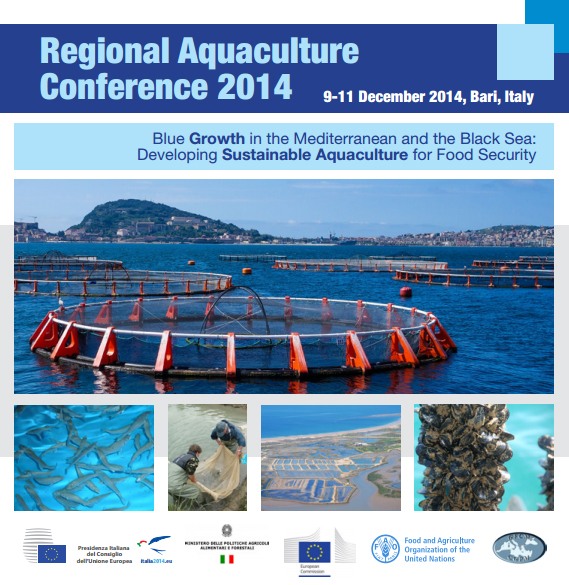
ANNEX
Draft outline for multiannual national plan for the development of sustainable aquaculture
1. National context and link with main national objectives
· National situation and strategic approach towards the EU main objectives
· Quantified national growth objective (2014-2020)
2. Response to the strategic guidelines
(a) Simplify administrative procedures:
(1) Assessment of the national situation:
(a) Qualitative description of the administrative set-up (main bodies responsible for licencing, distribution of responsibilities between administrations, etc.)
(b) Quantitative data and explanations: see list in the main text
(2) Main elements of the intended policy response: planned actions to reduce the administrative burden
(3) If applicable, corresponding quantified targets and indicators (e.g. expected reduction in administrative costs and/or time, etc.)
(b) Securing sustainable development and growth of aquaculture through coordinated spatial planning:
(1) Assessment of the national situation: existing framework for spatial planning (marine and on land), distribution of competences, spatial plans already in place.
(2) Main elements of the intended policy response: how spatial planning will be promoted taking into account the needs of aquaculture
(3) Where applicable, corresponding quantified targets and indicators (e.g. number and surface of new designated areas for aquaculture, number of regional plans adopted)
(c) Enhance the competitiveness of EU aquaculture:
(1) Assessment of the national situation: strengths and weaknesses of the national aquaculture sector, existing R&D support, areas where increased competitiveness is most needed
(2) Main elements of the intended policy response: planned activities to support innovation and links between R&D and the industry; etc.
(3) Where applicable, the corresponding quantified targets and indicators (e.g. n. of partnerships between industry and R&D actors)
(d) Promoting a level playing field for EU operators by exploiting their competitive advantages:
(1) Assessment of the national situation: producers organisations, existing schemes to recognise sustainability (e.g. voluntary schemes used by major national retailers), perception of aquaculture by the general population
(2) Main elements of the intended policy response (2014-2020): actions foreseen to improve the image of EU aquaculture products (e.g. communication campaigns, support to participation in voluntary schemes, support to organic aquaculture)
(3) Where applicable, corresponding quantified targets and indicators (e.g. percentage of organic and/or certified aquaculture, etc.)
3. Governance and partnership
· Key contributions from the main actors involved (regional and/or local authorities, industry, stakeholders and NGOs)
· Link with the EMFF OP priorities and financial allocations (EMFF and other EU or national funds)
· Name and contact details of the National Contact Point for the promotion of sustainable aquaculture
4. Best practices
· Identification and presentation of 3 national best practices
[1] For the purpose of this Communication, the word "seafood" includes all fisheries and aquaculture products
[2] SEC(2011)883
[3] DG MARE elaboration from Eurostat data
[4] DG MARE elaboration from STECF data (STECF-OWP-12-03)
[5] COM(2012) 494
[6] COM(2011) 425
[7] Directive 2000/60/EC
[8] Directive 2008/56/EC
[9] Regulation (EU) N°304/2011
[10] http://ec.europa.eu/environment/nature/natura2000/management/docs/Aqua-N2000%20guide.pdf
[11] JRC Technical Report "An approach towards European Aquaculture Performance Indicators"
[12] Data from FAO project SHoCMed, integrated with information from producers associations and public authorities
http://www.faosipam.org/?pag=content/_ShowPortal&Portal=SHOCMED
[13] http://www.europarl.europa.eu/committees/en/studiesdownload.html?languageDocument=EN&file=29819
[14] http://www.windbarriers.eu/fileadmin/WB_docs/documents/WindBarriers_report.pdf
[15] http://ec.europa.eu/enterprise/policies/sme/business-environment/administrative-burdens/
[16] COM(2012) 795 final
[17] For more information on the The High Level Group:
http://ec.europa.eu/dgs/secretariat_general/admin_burden/ind_stakeholders/ind_stakeholders_en.htm
[18] http://ec.europa.eu/maritimeaffairs/documentation/studies/documents/economic_effects_maritime_spatial_planning_en.pdf ;
http://www.windbarriers.eu/fileadmin/WB_docs/documents/WindBarriers_report.pdf
[19] JRC Technical Report "An approach towards European Aquaculture Performance Indicators"
[20] http://www.bim.ie/media/bim/content/BIM_CLAMS_Explanatory_Handbook.pdf
[21] http://www.intecmar.org/esga/
[22] http://www.mmm.fi/en/index/frontpage/Fishing,_game_reindeer/Fisheriesindustry/aquaculture.htm
[23] E.g. "Windspeed" roadmap http://www.windspeed.eu/
[24] Res. GFCM/36/2012/1 http://www.faosipam.org/GfcmWebSite/docs/RecRes/RES-GFCM_36_2012_1.pdf
[25] http://www.aquabestproject.eu
[26] COM(2013) 133 final
[27] http://www.europarl.europa.eu/committees/en/studiesdownload.html?languageDocument=EN&file=29819
[28] See e.g. http://ec.europa.eu/environment/nature/natura2000/management/guidance_en.htm http://www.project-gpwind.eu/
[29] http://www.europarl.europa.eu/committees/en/pech/studiesdownload.html?languageDocument=EN&file=29823
[30] COM (2012) 494
[31] Council Directive 79/409/EEC
[32] http://ec.europa.eu/environment/nature/cormorants.htm
[33] Eurostat data and http://ec.europa.eu/agriculture/analysis/markets/organic_2010_en.pdf
*
Sustainable only subject to sourcing fish feed that does not
include wild fish that may otherwise be fit for human
consumption.
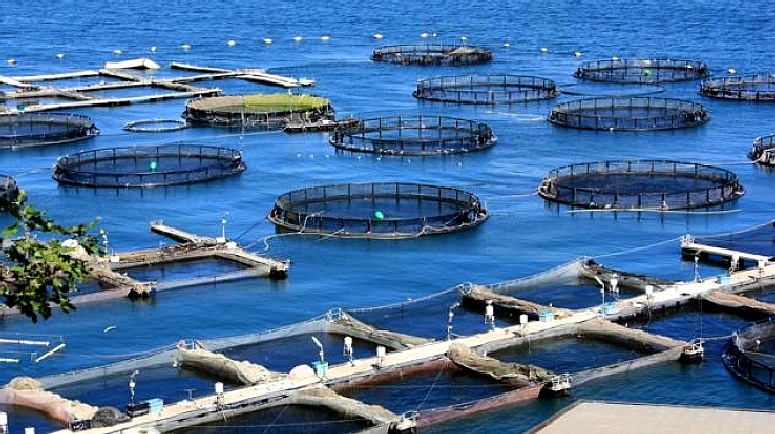

LINKS
& REFERENCE
https://aquaconference.com/
https://phys.org/news/2017-09-tiny-portion-world-oceans-global.html
https://snappartnership.net/our-work/solutions/
http://journals.plos.org/plosone/article?id=10.1371/journal.pone.0169281
https://www.nceas.ucsb.edu/
http://www.cart-sci.org/
https://www.gov.uk/government/publications/sustainable-aquaculture-the-united-kingdom-multiannual-national-plan-manp
https://ec.europa.eu/maritimeaffairs/policy/skills-career-development_en
This
website is provided on a free basis as a public information
service. Copyright © Cleaner
Oceans Foundation Ltd (COFL) (Company No: 4674774)
2019. Solar
Studios, BN271RF, United Kingdom.
COFL
is a charity without share capital.
|










